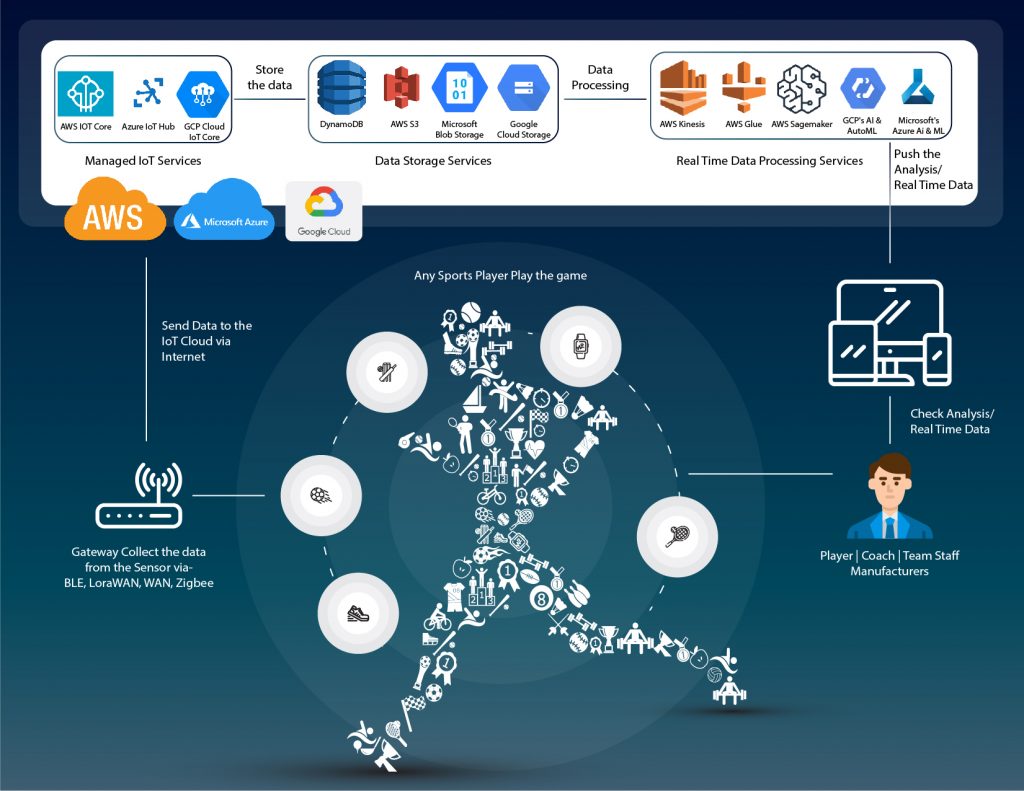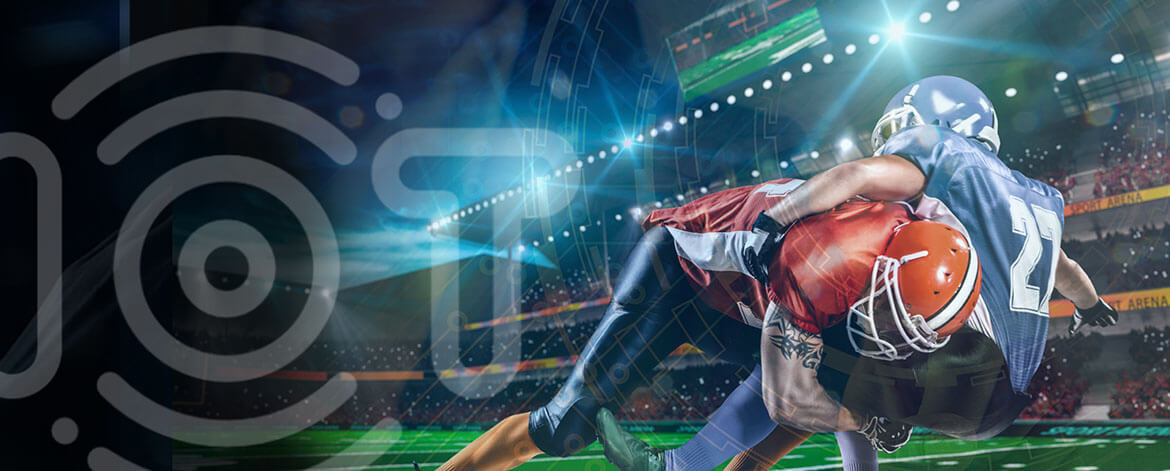The global smart sports equipment market size was valued at USD 2.16 billion in 2019 and is expected to reach USD 4.04 billion by 2027
Based on this upward trend, the sports industry is gaining prominence as the key market for connected solutions and the Internet of Things. Right from smart homes to smart cars and more, IoT has transformed many industries and has enabled OEMs to achieve breakthrough results beyond expectations. IoT in sports industry is no exception.
In the past, tracking athlete performance or health metrics was a daunting task. Most of the players and coaches relied on manually collected data, experience, hard work, training modules, and observation to improvise athlete’s strength and work on weaknesses. With technologies like IoT, connected solutions for sports allows coaches and players to draw objective conclusions regardless of the “good eye” of the observer.
Why IoT is the Growth Driver for the Sports Industry
Consumer-facing devices like Fitbit, Apple Watch, Gearfit have a high impact on athletes. These smart wearables can help athletes track vitals and performance metrics in real-time – taking their health and wellness into their own hands. Most of the traditional sports apparel makers have dedicated mobile applications such as Runtastic by Adidas, Runkeeper by Asics, and Endomondo by Under Armour. Because all kinds of connected sports applications are increasingly capable of measuring performance and reporting it to smartphones. This is the primary reason for driving the growth of IoT in the sports domain.
For instance, Microsoft came up with the IoT cricket bat which has a card size sensor on top responsible to collect the data such as the swing, angle, and speed of the bat. When the player hits the cricket ball, it sends the information to the nearest stump box which has the IoT gateway embedded and sends the information to the Azure IoT Hub. Now, once it collects the data, the machine learning algorithm gets executed on this collected data and at the end, the “quality of the shot and other relevant information” can be derived upon it. This can be applied on the same as a baseball bat. Motion sensors in the cricket ball can track the swing and spin under the different playing conditions bowled by different players with different wrist movements and grip.
To remain a competitive sports brand, it is a prerequisite to offer connected devices for superior customer engagement and leverage the increasing power of digitization in sports.
These technical developments in sports are resulting in the high growth of IoT-enabled connected sports solutions.
How IoT Plays a Major Role in Sports Industry

Sensor Integration & Transfer of the Data Using Gateway:- As you can observe in the diagram, a sensor chip such as (acceleration, motion) is integrated with the first contact equipment i.e. Cricket bat, Baseball bat, Racket, etc. which detects the various events as per the intelligence applied in it. Once the sensor collects the data, it transfers the data to the nearest gateway using wireless transfer techniques such as Bluetooth, LoRaWAN, Zigbee.
Cloud platforms:- The gateway collects the data from the different sensors and transmits to the connected cloud solution such as Amazon Web Service(AWS), Microsoft Azure, and Google Cloud Platform (GCP).
Cloud IoT & Storage Service:- These cloud platforms provide the advanced managed services that help us collect the data of the connected devices such as AWS IoT Core, Azure IoT Hub, GCP Cloud IoT Core and store it in the different data storage available in this cloud such as AWS S3, DynamoDB, Microsoft Blob Storage, Google Cloud storage.
Cloud Processing/Analysis Service:- From the stored data or live data to derive the meaningful conclusion or analysis, we can leverage the different machine learning and artificial intelligence managed services on the platform such as AWS EMR, Glue, Athena, Kinesis, Sagemaker, Microsoft’s Azure AI & Machine Learning, GCP’s AI & AutoML.
Data Visualizations Service:- Once we have a different kind of analysis and reports, we can utilize powerful data visualization tools such as Microsoft Power BI, Tableau in Mobile and Web Applications.
Thus, it gives real-time insights into the player’s performance and technique
IoT Application in the Sports Industry
Connected Sports Solutions for Athletes Implementing IoT-powered sensors in smart fabrics or smart insoles help athletes to track performance, heart rate, distance traveled, heart rate, speed, fatigue levels, metabolic charge, and so on. By collecting this data, players can better analyze their strengths and weaknesses, recovery levels, strategic positioning, and use data-driven feedback to get to the next level.
IoT sensors can improve an athlete’s safety by detecting potential injuries. For instance, smart insoles can recognize foot injuries in runners, while smart helmets can diagnose brain injuries after a fall or a blow to the head. Sports physicians can use this data to reduce injuries and help players heal faster. Moreover, sports manufacturers can also use the data collected by IoT sensors to optimize their products to meet each athlete’s specific needs.
Connected Sports Equipment Footballs and basketballs with embedded sensors can collect the data of shot and pass accuracy and strength of the players to help them analyze and track progress throughout the game.
Connected Solutions for Smart Stadiums Organizations can leverage IoT to drive venue efficiency through many initiatives such as traffic management, building performance, stadium security, energy optimization, and overall maintenance of the building to improve the game experience for the audience.
Potential Use Cases of IoT in Sports Industry
| Sport Categories | Sensors supported objects/devices | Type of Measured Data | Application Advantage |
| Running, Baseball, Football, Hockey, Cricket, etc. | Shoes | Speed, Accuracy, Distance travel | Can analyze & help in understanding player’s fitness and sprinting capacity |
| Gymnastic, Aerobic, Dancesport, Yog, Swimming, Kabaddi, Volleyball, etc | Wrist Band/Watch | Heartbeat, Oxygen level, Breathing, Distance traveled | Can check the player’s health condition & fitness during the different phases of the game and predict the general injuries |
| Cricket | Bat & Ball | Measure bat swing, Speed, Movement, Accuracy, Swing, Spin, acceleration | Can measure batting and bowling accuracy, speed and train the players accordingly. Even sports manufacturers can design the bat/ball according to suitable weight-size [Probably entire KIT] |
| Baseball | Bat | Measure bat swing, Speed, Movement, Accuracy, acceleration | Can measure hitting accuracy, speed and train the players accordingly. Even sports manufacturers can design the bat according to suitable weight-size [Probably entire KIT] |
| Tennis | Racket | Racket Speed, Angle, Acceleration, TouchPoints of ball | Can measure the hitting abilities and hand strength and train the players accordingly |
| Hockey | Hockey stick | Speed, Acceleration, Angle | Measure the hitting abilities and hand strength and train the players accordingly |
IoT in the sports industry can unlock the potential for sports equipment manufacturers and sportspeople – allowing them to make smarter decisions by monitoring their performance. Thus, sports companies must leverage the potential of IoT in sports. However, implementing IoT in sports is an intricate process. To realize your ideas into connected sports solutions, you need expert IoT solutions and service providers.
Read our case study to know how VOLANSYS helped the client develop an innovative solution for their end customers in the sports equipment segment.
Story 1: Sports Activity Monitoring Device Development Based on BLE
At VOLANSYS, we provide end-to-end IoT solutions and services for edge devices/sensors, cloud, and mobile/web applications. We also have hands-on experience in Artificial Intelligence (AI) and Machine Learning (ML) services to help enterprises, start-ups and OEMs across various industries develop custom solutions that ensure faster decision making, increased productivity, business process automation, and faster anomaly detection for the businesses. For more details, contact us.
Note: The content of this blog is based on the personal knowledge of any research work done by any individuals. There is a market research report on the smart sports equipment market that is used from the website grandviewresearch. Figures are kept to the best of our knowledge and not to mislead in any manner.
About the Authors:

Dhruvesh Soni
Dhruvesh is associated with VOLANSYS Technologies as Principle Engineer over 6 years. He has diversified experience of developing solutions for domains like Cloud, Internet of Things (IoT), Industrial Internet of Things (IIoT) and more across multiple industries bringing in value to our clients solutions.

Ankita Hariyani
Ankita is associated with VOLANSYS Technologies as a Senior Marketing Executive. She has the technical precision, business experience and creativity to craft technically detailed write-ups with ease. She has more than 4 years of experience in Marketing.









